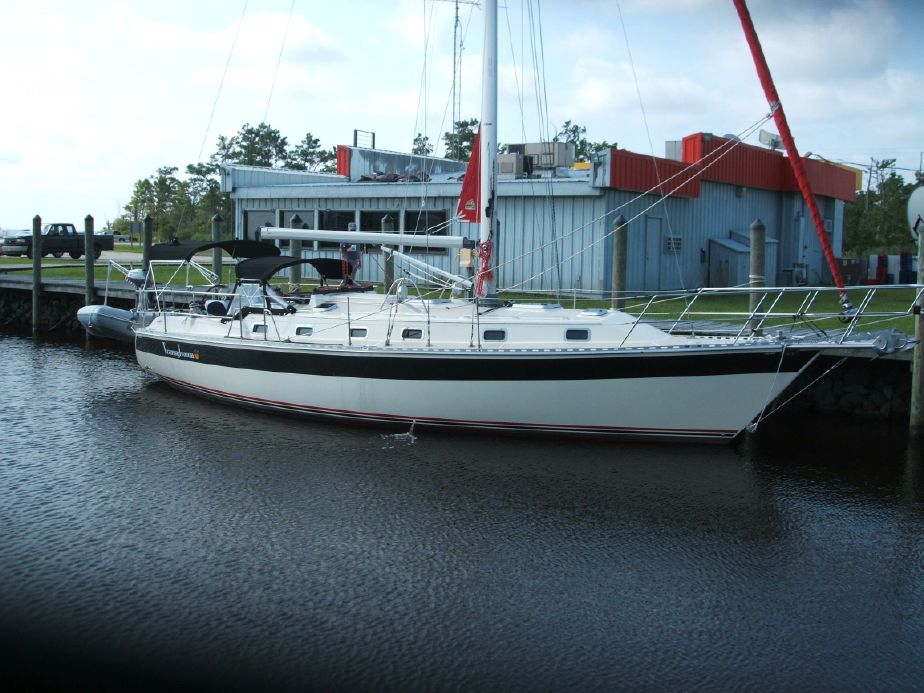The “LRC” in this model’s name stands for Long Range Cruiser, and while bluewater cruisers are clearly Caliber’s target with this design, there’s no reason quality-minded coastal cruisers, weekenders, and even daysailors should not take a look at the Caliber 40 LRC.
First introduced as the Caliber 40 in 1993, the model name was changed in 1994 to the 40 LRC to emphasize the company’s focus on this market segment. The only significant difference in the two models is a change from stand-alone tanks for fuel, water, and waste to integral fiberglass tanks and an increased fuel capacity from 46 to 212 gallons.
Designed by Caliber’s co-founder, Michael McCreary, the Caliber 40 LRC is moderate in nearly every way. This underbody features a long, low-aspect fin keel and rudder supported by a skeg forward and is a good compromise between the performance benefits of fin-keeled, spade-rudder designs and the directional stability of traditional full-keel designs. Above the waterline, the Caliber 40 LRC is not likely to win any accolades for her classic beauty, but her appearance is well-balanced and contemporary.
Built the old-fashioned way, at least as it relates to fiberglass boats, construction of the Caliber 40 LRC is among the best of production fiberglass boat builders. The hull is a hand-laid composite of alternate layers of 24-ounce, woven roving and chopped strand fiberglass cloth and resin. Every bulkhead as well as seats, berths, shelves, and cabinets are individually hand-laminated to the hull with multiple layers of fiberglass and resin adding considerable structural support. Fuel, potable water, and waste tanks are integral with the hull and below the cabin sole. There is a watertight crash bulkhead forward, and the hull is reinforced at the bow and along the leading edge of the keel.
The deck and cabin are constructed of fiberglass composites with equal attention paid to strength and quality control. The deck and hull are joined in a rather unique fashion. A polyurethane adhesive is used to seal the deck to the inward hull flange, and then a perforated aluminum toe rail is bolted through the flange every six inches with quarter-inch, stainless steel carriage bolts. The bolts are fit into square holes in the toe rail so that tightening the nuts will not cause the bolts to turn and break the caulking seal. This is trademarked the Quad-Seal Deck to Hull System and is a very strong and watertight method of deck to hull attachment.
The deck and cockpit of the 40 LRC are arranged in a manner that allows easy handling by a sailing couple. A “sugar-scoop” transom allows for easy boarding from a dinghy, and a fold-down ladder can be reached by someone in the water for emergency boarding. The T-shaped cockpit will accommodate four to five adults very comfortably, and the 40-inch diameter wheel allows the helmsman to sit outboard for better vision and still reach the wheel. A large-opening, port seat locker allows even the not-so-slim or less agile sailor access to machinery, batteries, packing glands, and steering gear below.
Although I prefer a more substantial toe rail than the perforated aluminum one Caliber provides, double life lines and cabin top hand rails add to safety going forward. On the foredeck, there is a large anchor locker with a secure closure and a bow pulpit/anchor platform for ease of handling and storing ground tackle.
The arrangement below deck is one of the best for balancing comfort, storage, utility, and practicality on a boat of this size and not coincidentally, is nearly identical to the arrangement we chose for our own boat. It features a full head and shower forward, followed by the master stateroom with a Pullman-styled berth to port and a hanging locker next to a bureau to starboard. The main cabin is amidships with an L-shaped dinette to port and a settee to starboard. The galley and navigation station are aft to port. A second small head and a smallish quarter berth cabin suitable for two small adults are to starboard.
Auxiliary power is provided by a 50-horsepower Yanmar diesel mounted below the cockpit and companionway. This is plenty of power for this nearly 22,000-pound boat, and access for maintenance and service is very good. If I have any complaint, from a powering standpoint, it’s the 40 LRC’s 216-gallon fuel capacity. Although there are two tanks of approximately equal capacity, few owners will ever need even half this much fuel. Because fuel doesn’t store well for long periods of time, I would have preferred one of the tanks to be in the range of 40 gallons and a second large tank for use only when needed.
The Caliber 40 LRC is rigged as a sloop/cutter with a removable inner forestay. Sail area/displacement ratio is 15.3, and displacement/length is 28, both quite conservative for a coastal cruiser, but more fitting of a bluewater cruiser. As would be expected, light-air performance is not her strong suit; although, most owners praise her performance in winds above six knots. Later models fit with in-mast furling systems sacrifice sailing performance for the convenience of the furling mainsail.
Used Caliber 40 LRCs currently on the market range from a 1996 model offered at $194,900 to a 2003 model offered at $249,900. Reported sales over the last six months range from $143,000 for a 1993 model to $265,000 for a 2007 model. There are plenty of less expensive used boats in this size and age range, but there may be no less expensive boats better built or better suited to the punishment extended cruising and bluewater passages can dole out.
Specifications:
LOA 40’ 11”
LOD 39’ 1”
LWL 32’ 6”
Beam 12’ 8”
Displacement 21,600 lbs
Draft 5’ 1”
Reviewed in the January 2009 issue of SpinSheet by Jack Hornor





